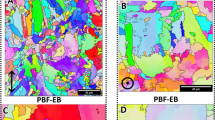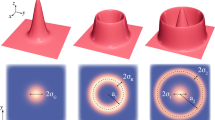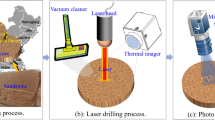Abstract
Transient temperature history is vital in direct laser deposition (DLD) as it reveals the cooling rate at specific temperatures. Cooling rate directly relates to phase transformation and types of microstructure formed in deposits. In this paper, finite element analysis simulation was employed to study the transient temperature history and cooling rate at different experimental setups in the Ti–48Al–2Cr–2Nb DLD process. An innovative prediction strategy was developed to model with a moving Gaussian distribution heat source and element birth and death technology in ANSYS®, and fabricate crack-free deposits. This approach helps to understand and analyze the impact of cooling rate and also explain phase information gathered from x-ray diffraction.




Similar content being viewed by others
References
K. Kothari, R. Radhakrishnan, and N.M. Wereley, J. Eng. Mater. Technol. 133, 24501 (2011).
C. Guoqing, Z. Binggang, L. Wei, and F. Jicai, Intermetallics 19, 1857 (2011).
H.F. Sun, X.W. Li, J. Feng, and Fang, W. Bin, Trans. Nonferrous Met. Soc. China (English Ed., 22(SUPPL. 2), 491 (2012).
K. Hashimoto, M. Kimura, and R. Suyama, Scr. Metall. Mater. 31, 449 (1994).
L. Yan, X. Chen, W. Li, J. Newkirk, F. Liou, J. Newkirk, and F. Liou, Rapid Prototyp. J. 22, 810 (2016).
E. Toyserkani, A. Khajepour, and S. Corbin, Opt. Lasers Eng. 41, 849 (2004).
K. Mills, Recommended Values of Thermophysical Properties for Selected Commercial Alloys (Cambridge: Woodhead Publishing, 2002).
G. Chen, Investigation on the Microstructure of TiAl Intermetallic Compound Electron Beam Welded Joints and the Crack Control Technology (PhD thesis, Harbin Institute of Technology, 2007).
Z. Fan, and F. Liou, Titanium Alloys - Towards Achieving Enhanced Properties for Diversified Applications, ed. A.K.M. Nurul Amin (InTech, 2012). http://www.intechopen.com/books/titanium-alloys-towards-achieving-enhanced-properties-for-diversified-applications/numerical-modeling-of-the-additive-manufacturing-am-processes-of-titanium-alloys.
L. Wang, S. Felicelli, Y. Gooroochurn, P.T. Wang, and M.F. Horstemeyer, Mater. Sci. Eng. A 474, 148 (2008).
J.C. Schuster and M. Palm, J. Phase Equilib. Diffus. 27, 255 (2006).
C. Matthias, J. Chem. Inf. Model. 53, 1689 (2003).
T. Kumagai and M. Nakamura, Metall. Mater. Trans. A 29, 19 (1998).
M.C. Chaturvedi, Q. Xu, and N.L. Richards, J. Mater. Process. Technol. 118, 74 (2001).
Acknowledgements
This project was supported by The Boeing Company through the Center for Aerospace Manufacturing Technologies (CAMT), National Science Foundation Grant # CMMI-1547042, and the Intelligent Systems Center (ISC) at Missouri S&T. Their financial support is greatly appreciated.
Author information
Authors and Affiliations
Corresponding author
Rights and permissions
About this article
Cite this article
Yan, L., Li, W., Chen, X. et al. Simulation of Cooling Rate Effects on Ti–48Al–2Cr–2Nb Crack Formation in Direct Laser Deposition. JOM 69, 586–591 (2017). https://doi.org/10.1007/s11837-016-2211-8
Received:
Accepted:
Published:
Issue Date:
DOI: https://doi.org/10.1007/s11837-016-2211-8




